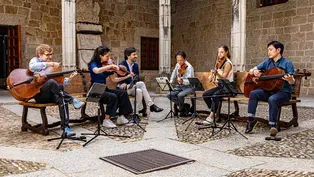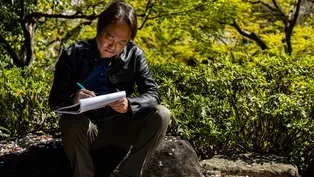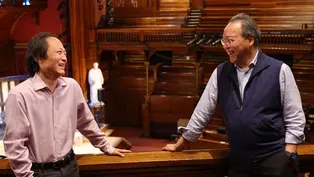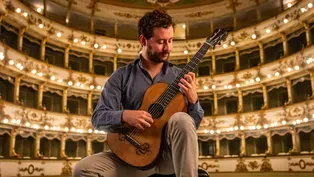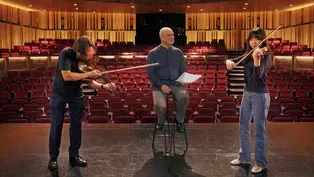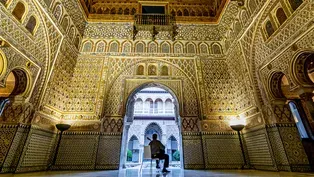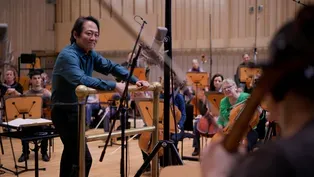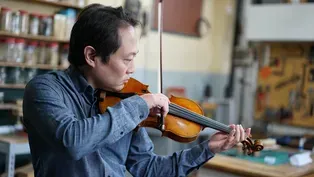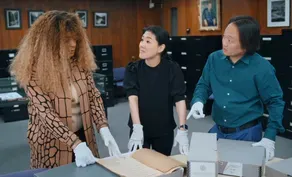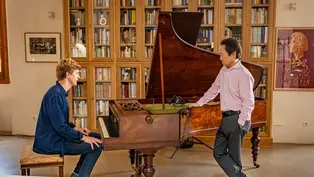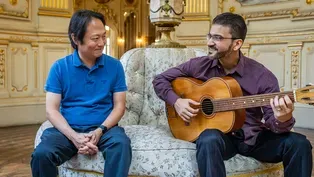
Now Hear This “Chopin’s Polish Heart”
Season 52 Episode 9 | 53m 54sVideo has Closed Captions
Explore Chopin’s musical evolution from Poland to Paris with Scott Yoo and pianist Jan Lisiecki.
Follow Scott Yoo and pianist Jan Lisiecki as they explore Chopin’s life, his Polish roots, and his journey to Paris taking a closer look at the composer's musical evolution and his deep connection to his homeland while living in France.
Problems with Closed Captions? Closed Captioning Feedback
Problems with Closed Captions? Closed Captioning Feedback
Major series funding for GREAT PERFORMANCES is provided by The Joseph & Robert Cornell Memorial Foundation, the Anna-Maria and Stephen Kellen Arts Fund, the LuEsther T. Mertz Charitable Trust, Sue...

Now Hear This “Chopin’s Polish Heart”
Season 52 Episode 9 | 53m 54sVideo has Closed Captions
Follow Scott Yoo and pianist Jan Lisiecki as they explore Chopin’s life, his Polish roots, and his journey to Paris taking a closer look at the composer's musical evolution and his deep connection to his homeland while living in France.
Problems with Closed Captions? Closed Captioning Feedback
How to Watch Great Performances
Great Performances is available to stream on pbs.org and the free PBS App, available on iPhone, Apple TV, Android TV, Android smartphones, Amazon Fire TV, Amazon Fire Tablet, Roku, Samsung Smart TV, and Vizio.
Buy Now

Great Performances Newsletter
Subscribe to the Great Performances newsletter to keep up with the latest full episodes to stream, exclusive content, and more!Providing Support for PBS.org
Learn Moreabout PBS online sponsorshipMore from This Collection
Now Hear This "Barrios: Chopin of the Guitar"
Video has Closed Captions
Discover Agustin Barrios’ rise from rural Paraguay to becoming a pioneering guitar composer. (54m 24s)
Now Hear This "Rachmaninoff Reborn"
Video has Closed Captions
Discover Rachmaninoff's reinvention as an American artist after losing everything in Russia. (54m 23s)
Now Hear This "Boccherini: Night Music"
Video has Closed Captions
Explore Boccherini’s love for Madrid through a musical night tour of the city with Scott Yoo. (53m 54s)
Now Hear This “The Composer is Yoo”
Video has Closed Captions
Follow host Scott Yoo’s journey to compose a piece of music for the first time. (54m 24s)
Video has Closed Captions
Explore how virtuosos become maestros, featuring Yo-Yo Ma, Lynn Chang and more. (53m 54s)
Video has Closed Captions
Explore the work of two legendary virtuosos, Niccolò Paganini and Robert Johnson. (53m 24s)
Video has Closed Captions
Visit Julliard Pre-College with Scott Yoo to play with some of tomorrow’s virtuosos. (53m 54s)
Now Hear This “Albéniz: Portraits of Spain”
Video has Closed Captions
Discover the inspirations Spain provided composer Isaac Albéniz with host Scott Yoo. (54m 25s)
Now Hear This “Andy Akiho Found (his) Sound”
Video has Closed Captions
Experience the creation of music from this Japanese American composer with host Scott Yoo. (53m 34s)
Now Hear This “Schumann: Genius and Madness”
Video has Closed Captions
Visit Scotland, Germany and France with host Scott Yoo. (53m 25s)
Now Hear This “Piazzolla’s History with Tango”
Video has Closed Captions
Tango to Buenos Aires, Argentina, with host Scott Yoo. (53m 55s)
Now Hear This "Florence Price and the American Migration"
Video has Closed Captions
Host Scott Yoo follows the trail of the great African American composer Florence Price. (54m 25s)
Providing Support for PBS.org
Learn Moreabout PBS online sponsorship♪♪ -Coming up on "Great Performances"...
I'm Scott Yoo.
In 1830, Frédéric Chopin left Poland, never to return.
He found kindred spirits in Romantic era Paris.
-He and Chopin met in this very, very room we are standing in.
Chopin would have been playing some miniatures of his own.
-He was inspired by new piano technology... -This action allows you to make quick, swift changes of colors and dynamics.
-...to create a new kind of piano music... ♪♪ -This -- -How come that's an étude?
-The difficulty is, of course, to sing it.
He always told his students, "Chantes, chantes.
Sing, sing."
-...music that was new but rooted in the old music of his homeland.
-I think a part of the soul of Chopin is inside.
-For though Chopin left Poland, it would never leave him.
-Chopin came with his own ideas, his own way of writing.
He liked to write beauty for the sake of beauty.
-Come with me and Polish-Canadian pianist Jan Lisiecki on the next "Now Hear This" to know Chopin's Polish heart.
♪♪ Major funding for "Great Performances" is provided by... ...and by contributions to your PBS station from viewers like you.
Thank you.
♪♪ -In the Hôtel Les Invalides, Napoleon's veterans' hospital, is the Museum of Relief Maps.
It houses military models, from a time when Europe was almost constantly at war.
I met with their director, Isabelle Warmoes.
-This model is showing the art of siege warfare used a little before the period of Chopin.
And you can see the encampment of the army near the city they want to attack.
-There seems to be a wall there.
-Yes.
To protect the encampment from the cannonballs of the city, they had to build this fortification of earth.
-So, are they working at night?
-Yes, because during the night, nobody can see you, and they can put cannon to bombard the city.
-Interesting.
-Now, to go inside the fortification, they are making a tunnel.
-It's very, very bold.
-And you can see that cannonball start to destroy the fortification to permit the soldiers to go inside, and the city will be down in a few moments.
-With foreign powers occupying Poland, a young Frédéric Chopin fled for Paris.
-So, these kind of military models were made to understand the fortification and the landscape.
And with this kind of models, the king could see all the cities without moving to the border.
-To see the vulnerabilities of the city or something?
-Exactly.
-Interesting.
-All the buildings are made of wood and paper.
All the trees are made of silk.
It's cartography, but pieces of art, too.
-It's both.
-It's both, really.
♪♪ -Like these models, Chopin built musical worlds in miniature.
♪♪ Because he wrote mostly for piano, I don't know him well.
So I've been reading his letters.
He said, "I can express my feelings more easily if they're put into notes of music."
But his writing shows a gift for language and reveals an art shaped by his homeland, close friendships in Paris, and a quest for the purest music.
♪♪ To help me understand Chopin, I called Polish-Canadian pianist Jan Lisiecki.
♪♪ ♪♪ It's so nice that they keep this so beautiful for everybody to enjoy.
-Absolutely.
-Chopin was born in the Polish countryside outside Warsaw.
I'd start there with Jan and Polish cellist Maria Leszczynska.
It's a pretty opulent place for the Chopins to live.
-Well, not quite.
Chopin's father moved here as a teacher to the aristocratic family that lived on the grounds, met his mother, who was a down-on-her-luck aristocrat, and they married.
They lived here in a servants' house, and, in fact, this is the very house in which Chopin was born.
We're about to visit it now.
-You know, even as servants' quarters, this is really beautiful.
It's kind of lavish.
-In Chopin's time, it probably would have looked quite different, more like a barn, possibly even with a dirt floor.
It was not nearly as beautiful as it is today.
But in any case, I don't think that matters very much since he didn't stay here very long.
-Yeah, they were here only for a few months.
They moved to Warsaw, actually, because his father started teaching at the private high school.
And Chopin was also educated there, so he was really well-educated.
-So, in Warsaw, he was surrounded by this high society, by the nobility, by culture, by art.
And he would still continue to come here as a family for holidays, so in Zelazowa Wola, he had the rural Polish experience.
I think that really shaped who he became -- the nobility of Warsaw, the culture of Warsaw, and the Polish culture of Zelazowa Wola.
-Can we go inside?
-Without a doubt.
-Okay.
I've never played this piece before.
-Neither have I.
It's not played so much.
But I think, as one can imagine, Chopin was quite a child prodigy.
He started composing when he was 6.
He continued writing through his youth, his teens, and into his adult life.
This piece somehow still has some of that youthful energy, and I believe he wrote it for an exam, didn't he?
-Yeah, I think so.
During his studies.
Yeah, he was really young this time.
-I wonder what mark he got for this.
-I bet an A. I would give him an A.
-For sure.
-Let's try it.
♪♪ ♪♪ If this sounds like a Beethoven trio, he was one of Chopin's early influences, though Chopin would soon find his own path.
In one letter, he wrote, "Beethoven challenges the universe.
I decided my universe would be the soul and heart of man."
♪♪ ♪♪ Chopin landed in Paris at 20 years old, and was embraced by other artists of the French Romantic movement, like the painter Théodore Géricault, famous for his horses.
Jan and I went to see them at the Museum of Romantic Life with French cellist Camille Thomas.
♪♪ Yeah, this one is really special.
-Just the light.
-Yes.
-And it's such a simple subject, that it can be so poetic, can have so much meaning.
A little bit like Chopin's music, I think.
It has this simplicity but complexity and leaves space for your own emotions in that.
-Emotion and expression, for sure.
It's almost human.
-It's beautiful.
-And listening, aware, you know?
He's open.
-Géricault was a good example of French romanticism.
And Géricault loved horses, studied them in Versailles, spent a lot of time making sure that his depictions were true to how they looked.
And he actually did a lot of miniatures just like Chopin.
And it's actually likely that he and Chopin met in this very, very room where we're standing, and Chopin would have been playing some miniatures of his own.
Géricault might have exhibited some of these paintings.
Also like Chopin, he led a similar life.
He started very early, had his first major success at the age of 21, a true masterpiece, but died young.
-Oh!
What a beautiful room.
-Stunning.
So, before becoming the Museum of Romantic Life, this was Ary Scheffer's house, and he lived here for about 20 years and hosted, in these very rooms, salons, which guested the likes of Chopin or George Sand.
What makes that quite interesting is Chopin was different than the rest of them.
While we may think Chopin's music is Romantic because of the emotions we feel when we hear it, actually, in definition, it is not Romantic.
Romantic artists would focus on creating art that was linked with nature, with a storm or the sea or some certain ideal.
But Chopin liked to keep his music pure.
He liked to write beauty for the sake of beauty.
-It's almost like he went in the opposite direction from the Romantics.
He's almost the negative image of a Romantic composer.
-He wrote little pieces, shorter pieces, for one instrument, versus the Romantics, which were trying to push the boundaries -- larger orchestras, longer symphonies.
But Chopin came from Poland with his own ideas, his own way of writing.
And despite being surrounded and embraced by these Romanticists, he stuck to his own voice.
-That voice was rooted in the music of Poland, where we met Janusz Prusinowski and his folk music quartet.
-[ Singing in Polish ] ♪♪ ♪♪ ♪♪ -Bravo.
Fantastic.
-Amazing.
-This is a wedding song known in the whole of Poland.
It's a mazurka, or one kind of mazurka.
People from the Mazovia region were named, normally, Mazur.
So, I'm Mazur, we are Mazurs.
So, the music they brought with them was Mazurek.
-Are all Mazurkas one-two-three, one-two-three?
-Exactly.
But this one-two-three is never even.
-Okay.
-And these melodies, these rhythms, are also connected with the rhythm of Polish language, which has regular accents on the second syllable from the end.
-I see.
-Mazurka.
Warszawa.
Kochania.
But the accent is always regular.
Ta-dana, one-two-three, one-two-three, one-two-three, one-two-three, one-two-three.
You can accent it even in such over-exaggerating way.
-One-two-three, one-two-three.
-One-two-three, one-two-three.
For example... [ Singing in Polish ] ♪♪ ♪♪ ♪♪ -Bravo.
-Chopin was fascinated with village music, and he used this language as a base, as a crucial idea for many, many of his melodies -- of his mazurkas, but not only mazurkas.
And I've heard that in his time, there were much more melodies recognized.
Even if he quoted short lines, people all recognized that's part of this song, part of this melody.
Then after 100 years, 200 years, almost nobody recognizes this melody.
For example, listen to this one.
[ Singing in Polish ] ♪♪ ♪♪ -Do you recognize that one?
-Yeah, it's amazing.
It's the Mazurka Opus 24 No.
1, G minor.
-So, he's stealing from the best.
-Yes, or preserving it for future generations.
One can look at it both ways.
-Fantastic.
♪♪ ♪♪ Chopin brought this popular Polish dance into classical music.
He wrote dozens of mazurkas and inspired many other composers, Polish and otherwise, to do the same.
Camille took us to the National Library, to their music archives, to see the original manuscripts of Chopin and one of his closest French collaborators.
-It's incredible because it's the first time I see that.
It's so moving.
I want to cry, really.
The first time I see it in real life.
-You've spent a lot of time with this music.
-Yes, but through the Internet.
So, this manuscript that we all have here are by Chopin, but a lot are copied by Franchomme.
Franchomme was a cellist, and I am so lucky to play today on the Stradivarius that Franchomme used to play.
-Does it play Chopin automatically?
-[ Laughs ] I think a part of the soul of Chopin is inside, really, and of Franchomme, too.
-Sure.
-It's never automatic, unfortunately.
[ Laughs ] This one is the first piece they worked together on.
-It's so clean.
-Yeah.
Oh!
[ Laughs ] -Okay, so, some errors were made.
-So, Franchomme was a friend, but also in the business of going to the editors, he helped Chopin a lot.
-And here's a letter, I think, where Chopin is sending Franchomme some music.
-Yes.
Exactly.
So, it's starting with this amazing word, "chérissime," which is the most beautiful way to address to a friend, like dearest.
And he's in Nohant, where he spent the summer, and he mentioned George Sand, "Madame Sand sends you greetings."
-And George Sand, of course, was another very important figure in Chopin's life in Paris.
-To be clear, George Sand is a woman.
-She's a woman.
She was a writer who took a male name in order to be published, of course, in those times.
She was quite a character, and Chopin and George were lovers, yes?
They spent 10 years together.
They inspired each other, I think.
-Yes.
They did, yeah.
-Very much.
I think we have in front of us here two very important people in Chopin's life.
We have Franchomme, one of his best friends in Paris, and George Sand, his lover.
-In Poland, we headed to Warsaw, to the Church of the Visitants.
♪♪ -Beautiful.
It's an amazing church.
-This was a key place in Chopin's youth.
Here we met their organist, Michal Markowski.
-It's actually the only church that survived, intact, World War II.
It's from the mid-18th century.
-It's a good one.
-Absolutely incredible.
♪♪ -[ Singing in Polish ] ♪♪ ♪♪ ♪♪ ♪♪ -Bravo, Michal.
It's beautiful.
-Amazing.
-So, Chopin played here?
-Yeah, in this church.
-In this very church?
-Exactly.
-It's incredible.
-Yeah, it's incredible.
But true.
Playing organ here during the mass, the whole mass, and he used this space for music.
-I mean, of course, when people think of piano, they think of Chopin, right?
I didn't know that he played organ.
Did he like it?
-I think, yeah, he did.
-I heard that during mass, sometimes they'd have to come up here and shake him to stop playing because otherwise -- -It's a true story.
It's a true story because he played improvisation, and it used to take time and... -Very loud.
-Yeah, it was very loud.
-So, you couldn't hear when the mass was supposed to start, when Chopin was playing.
-And did the organ affect or inform how he wrote for the piano?
-Certainly, his experience here in playing would have informed his decisions, in the fact that he had to improvise.
And of course, the exposure to all the hymns, all the themes that later, some of them we even know, directly ended up in his compositions.
Isn't that right?
-Yeah, that's right.
-Now, is Chopin ever played on organ?
I mean, is that ever done?
-Not so very much, but I think it can be done.
I have one piece in mind that maybe might work.
Do you think I could play your wonderful instrument?
-Yeah, of course.
Great idea.
♪♪ -Oh, I know this one.
-Yeah, this is the Prelude, Opus 28, No.
4.
And we know that Chopin specifically requested to have this piece played on the organ... at his funeral.
-Wow.
♪♪ ♪♪ ♪♪ Heartbroken over his occupied homeland, Chopin wrote, "I can only I groan and suffer, and pour out my despair at the piano."
To get a feel for Chopin's Poland, we visited the Director of the National Theater, Waldemar Dabrowski.
Back in his time, how did Polish people see him?
-He was very soon recognized as a genius.
He was even more than a genius.
He was the hope for the future.
-So, what was the state of Poland during Chopin's time?
-Poland as a state didn't exist.
We were torn apart by authoritarian powers, superpowers -- Russia, Prussia, and Austria.
There was 120 years of lack of independence.
-What exactly happened that made him have to leave?
We think that his friends who knew him as an enormous talent, they wanted to have him outside of Poland when the uprising was going to burn.
They didn't want him to fight.
They didn't want him to die.
-Can you tell me about the November uprising?
I don't really know what that is.
-It was 1830 when young Poles decided to fight the Russians.
But of course, the power of Russian soldiers was incomparably bigger than these young Polish guys.
So, from the very beginning, it was obvious we were not going to win it.
-As far as I understand it, Chopin would have had to get a Russian passport to come back -- and by that, accepting the rule of Russians.
-Yes, that is exactly what you are saying, Jan.
He didn't want to accept a Russian passport, and he had no way to travel outside of France, especially to Poland.
But I tell you, frankly, I think he's still present in Poland.
For us, you know, for Poles, we have a special place in our hearts to keep Chopin.
He is really part of our identity.
-Back in Paris, we took a break in the courtyard of the famous Studio Saint-Germain.
So, Jan, how many recordings of Chopin have you made?
-Already four recordings.
-How about you, Camille?
-Three in one.
-Nice.
-A trilogy, but one Chopin project.
-I feel like young musicians today are really going into Chopin.
What is it about Chopin that makes people want to go there?
-His music is just great.
It never had a down moment.
He's not a composer we've had to rediscover.
-He certainly mastered doing hits, short hits.
Hits that stay in your brain, in your heart, and that you'll never forget.
Themes that are eternal.
-Do you think he would have liked recordings?
-Yeah, I think so.
His students wrote about him that when he was improvising, he was at his best.
-Wow.
-And the difficulty for him was then to rewrite this improvisation.
-Remember again, and write it down.
-Yes, exactly.
-Of course, Chopin didn't really like to play concerts, right?
He liked to play for himself or a small group of friends in a salon environment.
I think for that reason, maybe playing in front of the microphones would have been preferred for him.
-For sure.
-And it was also actually a way to meet prospective clients, at the salon.
-Clients for what?
-For teaching.
Because for him, a big part of his income, his life, was teaching students.
Of course, here you had the aristocrats who wanted to learn from the very best.
You heard Chopin, you heard him improvise, and then, well, wouldn't it be wonderful to have a good teacher like that?
-You want to go back to the studio?
-With pleasure.
-Alright.
-Chopin was a very famous teacher, the best paid teacher in Paris at the time.
To be able to say that you were taught by Chopin was something special.
He was also paid more to support the cause.
As a refugee from Poland, people wanted to ensure that he had a good life and that he was able to compose.
And by paying him more for teaching, that was a way to support him as well.
As part of his teaching, he wrote pieces, in particular in the two books of études, or more literally, studies.
While each étude focuses on a particular challenge, I think the overarching aspect is one of maintaining music.
These are true works of arts.
For example, one of the études has this very famous and phenomenal theme.
♪♪ -How come that's an étude?
-Because the melody is so beautiful, but it has to be completely above everything else.
In the right-hand, you're playing multiple things at the same time.
-I know that he loved the cello and the voice.
I'm always impressed by pianists who can really sing with these hammers, you know?
-He always told his students, "Chantes, chantes.
Sing, sing."
Some others are more purely technical.
Chromatic scales are also difficult.
But here, he adds little chords in the bottom part of the hand.
So, you're playing the chromatic scale with two fingers.
So you're playing with the fourth and fifth finger, the whole scale.
Those two fingers, of course, share a tendon.
So it's very, very difficult to play, especially on a modern instrument.
♪♪ So, the challenge is to maintain the musical aspect of it, always present.
The technique is in the background.
You focus on the beauty of the music, and of course, you play everything perfect.
♪♪ ♪♪ ♪♪ ♪♪ ♪♪ ♪♪ -Today, Chopin represents many things to the Polish people.
Revered artist.
Lyrical mystic.
Suffering poet.
National hero.
In Warsaw's Chopin Museum, we met the Director of the Chopin Foundation, Stanislaw Leszczynski.
So, Stan, we landed in Chopin Airport.
There's a Chopin Music School.
What is it about Chopin's music that the average Polish person can relate to?
-You're right.
This is a very special figure in our culture because of the incredible idiomatic Polish roots in his motives, his melodies, his everything.
-So, would you say that Chopin's music translates Polish culture for the rest of the world?
-Exactly, yes.
And we can find everything in emotional, in aesthetic sense, in power, we can find it in miniature.
So, people are able to pay attention for just this three or four minutes.
-One or two minutes, sometimes.
-Sometimes even one minute.
And they recognize, in this short time, somebody who's speaking about life.
-So, Chopin's music is relevant to Polish people, or everyone, actually... -Everyone.
-...today.
-Yeah.
-Because we all hear it, and we find our own story in this music.
He leaves a lot of space for creating that story.
We think Chopin, we think Romantic music, we think it's this great story.
But that's our story.
That's not his story.
-So, I hear that you have a really interesting collection of pianos.
-Yes.
-So, your collection is there to show both the audience, but also professional pianists, what Chopin's music sounded like in Chopin's time.
-Never can we come back to this original sound.
Never.
But we feel very clear that we are going very near to this.
After some time, when you recognize that an old piano is not only an out-of-tune modern piano... -[ Laughs ] -...so, you can notice immediately that it's full of colors.
-Our guide to the Chopin Foundation's collection was Polish pianist Tomasz Ritter, a period instrument expert.
♪♪ ♪♪ I've never heard the Moonlight Sonata sound like that.
It's almost like a different piece.
-It sounds quite different from a modern piano, right?
This is because we are sitting at a copy of a Conrad Graf fortepiano from around 1819, built by Paul McNulty.
This is a Viennese type of piano that, for example, Beethoven knew during his lifetime.
At the same time, Chopin was 9 when the original of this piano was built.
What you can hear at the beginning is the totally different color from what we know today.
And I think the main quality here is the softness and the lightness of the action.
-But Chopin would have been familiar with this type of instrument from his youth, right?
-Yes, so, you can imagine Chopin learning all his habits and his style on such an instrument.
And you can understand why, because the lightness just wants you to play all kinds of embellishments in a very soft manner, for example, like this early Chopin's Polonaise.
♪♪ ♪♪ ♪♪ -That's beautiful.
And you'd think that Chopin probably carried this with him for his entire life.
What you learn as a child, you remember.
-Yes, of course.
The things that you learn at first stay with you for your whole life.
So, on this instrument, you can notice there are a little bit more pedals than we are used to.
This is because we have also a moderator, which was very popular in the early pianos.
A moderator is a piece of felt that goes between the hammer and the string.
And this is the moderator.
♪♪ So, you can imagine in his early nocturnes, for example, using this as a tool to paint some very distant picture, for example.
♪♪ ♪♪ ♪♪ ♪♪ -So, this kind of an instrument kind of forces the composer's hand to go for the lighter, softer end of the palette.
-Yes, you're right.
But this action allows you to make quick, swift changes of colors and dynamics.
And while it's not the biggest fortissimo, still, comparing to the lowest pianissimo, it's a lot of contrast.
So, another example of this more dynamic version of this instrument may be Chopin's first scherzo, which he wrote in a very dramatic period of his life.
And he wrote in his letters that he was raging at the piano about his problems and his emotions.
So, the scherzo can go from very light scherzo-like character... ♪♪ ...to much more dramatic sounds like this.
♪♪ ♪♪ -It's almost impossibly fast.
-Actually, on these pianos, you have to be super careful about the control, because it's very easy to go too fast.
-So, had Chopin written music today on a modern concert grand, you could argue that his music would have come out completely different?
-Oh, yes, for sure.
The instrument he had influenced him a lot.
-And I think we feel that during Chopin's lifetime.
He writes in a very different way once he moved to Paris, and, of course, the pianos are changing quite drastically in the early 19th century, and Chopin's music was changing along with it -- while always maintaining that tradition, that brillante style that he grew up with as a child.
-In one of just two trips outside France, Chopin went with George Sand to the island of Mallorca to escape the Paris winter in hopes of a milder climate.
-Remember that George Sand was a remarkable woman in her time.
She was eccentric.
She wore pants.
She smoked cigars.
She swore.
And she had two children from another marriage, living under one roof with a man to whom she was not married.
That man being Chopin, of course.
That was not accepted by the local population, which was quite conservative, on Mallorca.
Furthermore, Chopin was sick, and it was rumored that he had tuberculosis.
That was also a very big fear.
And when they got kicked out, Chopin was actually forced to pay for the replacement of the furniture -- they burned the old ones -- painting of the walls, disinfection of the apartment, and they had nowhere to stay.
Finally, they found a place in Valldemossa.
Valldemossa was a monastery which had been abandoned only a few years earlier, and they rented two cells.
They stayed there most of the time, but they did come here to the Ermita, and I think you can see why he was inspired.
And Chopin, in his letters, was in awe.
He loved the color of the sky, the sea, the mountains.
He compared it to sapphires, to lapis.
The beauty was really special for him.
But they spent most of their time down in Valldemossa.
-The cells in the monastery where Chopin and George Sand lived are now a museum.
That's not a bad place to have a backyard.
-Not at all.
Lemon trees, orange trees.
Beautiful view.
But as beautiful as it is right now, we're looking at it, and we think it's stunning.
In the winter, this is actually the coldest place in Mallorca, so it gets quite chilly.
The winter that Chopin was here was exceptionally cold, and they had -- apparently, at some times, they had knee-deep snow.
So, if you can imagine, here in beautiful Mallorca, but they were in snow.
So, it wasn't quite as beautiful as we see it today.
-So, just bad luck upon bad luck upon bad luck.
-A little bit.
A little bit.
-Upstairs in the museum is an original Pleyel grand piano, exactly like Chopin preferred in Paris.
♪♪ ♪♪ -George Sand called this prelude the Raindrop Prelude because of the persistent note that just continues.
-It's like variations around one note.
-Very much so.
-That takes kind of a special genius to pull that off.
-Most definitely.
-Incredible.
-It's a beautiful idea, so simple and elegant -- as always with Chopin.
And it transforms from something very light into something very dark, which perhaps also reflects his time here.
He wrote many famous works -- the Preludes, Opus 28, 24 of them.
Also, a Ballade, a Scherzo, a Polonaise.
But his relationship with George Sand was tested by the locals, by the situation that he was living in.
His health deteriorated quite a bit, and he wanted to leave as soon as possible to return to better climates, to better locations.
♪♪ ♪♪ ♪♪ ♪♪ -Their winter in Mallorca was so dark that George Sand wrote a book about it.
But it produced some of Chopin's finest work.
He wrote, "There are certain times where I feel more inspired, filled with a strong power that forces me to listen to my inner voice."
♪♪ ♪♪ ♪♪ ♪♪ ♪♪ ♪♪ ♪♪ ♪♪ There's a famous Chopin Festival each year at George Sand's Summerhouse, a few hours south of Paris.
We met Festival President Yves Henry.
-So, after Mallorca, Chopin spent his summers here, yes?
-Yes.
He arrived with George Sand and the children on the first of June, 1839.
-Amazing.
It was seven summers total he spent here?
-Yes, from 1839 to 1846, from April to November.
-Amazing.
-He wrote a lot here.
It was very productive for him.
-Yes.
It's why it's so important, George Sand in Chopin's life, because she gave him conditions to create.
And he composed so many masterpieces here, almost all after the preludes were written here.
-Because, of course, in Paris, he was busy teaching.
-Exactly.
-Here, he had nothing but to write.
But he had to write also, to survive.
-And there is a letter from Chopin to his secretary in Paris.
Just before leaving, he said, "I have to finish, because when I want to go to Paris after, I have no time to compose."
-Why do you think French people are so hungry to hear Chopin for six weeks here in the country?
What is it about Chopin that makes them go wild?
-All over the world, people like the music of Chopin because it's a music that gives you, immediately, sentiments.
And it's very important that this music can touch your heart immediately.
And there's maybe two composers like that -- Mozart and Chopin.
It's impossible.
-[ Chuckles ] -Can we go in?
-Yes, of course.
-Okay.
-Please.
-What a pretty house.
When was it built?
-1780, something like that, just before the Revolution.
-It was in the family, yes?
-Yes, George Sand, when she was a child, she was here with her grandmother.
-Really?
-Please.
-Thank you.
-Here is George Sand's room.
-Right next door to Chopin's room?
-Exactly.
-Wow.
-So, you can imagine that she wrote here during the night.
-And Chopin composed during the day.
-So, in the day, George Sand slept, and just here, Chopin composed.
-George Sand had the closest first-hand experience of Chopin at work.
She wrote, "His creation was spontaneous, miraculous.
It came to his piano suddenly complete."
-And the piano, probably, we imagine, was here or here.
-"But then he would begin the most heartbreaking labor, repeating and changing a single measure a hundred times with a desperate perseverance.
He would spend six weeks on one page."
-It's probably in this room that Chopin spent most of the time, where he composed all the day.
-Right here?
-Yeah.
You can imagine the grand piano, the sound of the music.
Beautiful sound.
-I've heard there's a historic piano in this house.
Do you mind if I go play it for a little bit?
-Yes, of course.
Please.
-It's downstairs?
-Yeah.
Please.
-Thank you.
-You can go by this way.
♪♪ ♪♪ ♪♪ -Improvisation and perfectionism are strange mates.
But they gave birth to a music that's both fresh and eternal.
♪♪ ♪♪ ♪♪ -When Chopin was here over so many summers, actually, the relationship with George Sand starts to become more complicated.
George Sand had some plays that weren't as successful as she had hoped, and were very expensive to put on.
Chopin had declining health, and it came to a point that George Sand wrote that she had three children because she was also taking care, in that sense, of Chopin.
So, this was a very fruitful state, but also marked the beginning of a decline.
♪♪ ♪♪ -So that's Franchomme's cello?
-Yes.
The Stradivarius that Franchomme used to play and that he played with Chopin.
So, this cello inspired Chopin and even accompanied Chopin through his last moment on Earth.
And the last letter, two months before his death, he's writing to Franchomme.
And the end of the letter, I will say it in French because he wrote it in French, it's... [ Speaking French ] It means in English, "I love you, and it's all that I can say for now, because I don't have enough strength."
And on the last day, friends were coming, and he asked Franchomme to play for him the third movement of the cello sonata they composed together.
And he chose this very movement, which is not a sad movement, no?
It's -- yeah.
-Peaceful.
No pain, no suffering.
-Yeah.
The last note he heard came from this piece of wood.
-I'd love to hear it.
♪♪ ♪♪ ♪♪ ♪♪ ♪♪ ♪♪ In this last work, Chopin aimed, as always, for simplicity.
He wrote, "After all the difficulties, after having played an endless number of notes, it is simplicity that matters.
Anyone who strives for this to begin will be disappointed.
You cannot begin at the end."
♪♪ ♪♪ -When Chopin died in 1849 in Paris, one of his final requests was to open up his chest, remove the heart, and have it brought back to Poland.
And it actually came here to this very church.
-It's a unique request.
-His eldest sister took it upon herself to smuggle it in past the Austrian authorities, past the Russian authorities, and into the city here, and brought it to this church, which was their family church, the Chopin family church.
-[ Speaking Polish ] -[ Speaking Polish ] -[ Speaking Polish ] -So, this is hallowed ground.
-Most definitely.
[ Speaking Polish ] -[ Speaking Polish ] ♪♪ -Chopin's eldest sister, Ludwika, actually spearheaded the movement to have his heart moved from where it was in the crypt to the upper parts of the church, where she felt it belonged.
And in fact, it was a social movement, because people of Warsaw, people of Poland, gave donations.
And that's why not only is the heart here in this nave, but it also says, "To Frédéric Chopin, from his compatriots."
-That's a beautiful sentiment.
-To be here, to be playing in front of it, one really can't get any closer to Chopin.
♪♪ ♪♪ ♪♪ ♪♪ -Chopin was only 39 when he died.
He'd spent the second half of his life in France.
And without the Romantics of Paris, especially George Sand, to inspire and support him, he may never have created the magnificent works that inspire us today.
♪♪ ♪♪ ♪♪ ♪♪ ♪♪ ♪♪ Chopin's heart, though, has always belonged to Poland.
I'm Scott Yoo, and I hope you can now hear this.
♪♪ ♪♪ ♪♪ -[ Singing in Polish ] ♪♪ [ Whooping, band playing upbeat music ] ♪♪ [ Singing in Polish continues ] -This program is available with PBS Passport and on Amazon Prime Video.
♪♪ To find out more, visit pbs.org/greatperformances.
Find us on Facebook, and follow us on X.
[ Singing in Polish continues ] -Whoo!
Whoo-whoo!
[ Exclaiming indistinctly ] Whoo-whoo!
♪♪ ♪♪
First 10 Minutes of Now Hear This "Chopin"
Video has Closed Captions
Clip: S52 Ep9 | 9m 28s | Enjoy this sneak preview of Now Hear This "Chopin." (9m 28s)
Now Hear This “Chopin’s Polish Heart” Preview
Video has Closed Captions
Preview: S52 Ep9 | 30s | Explore Chopin’s musical evolution from Poland to Paris with Scott Yoo and pianist Jan Lisiecki. (30s)
Now Hear this Season 6 Preview
Video has Closed Captions
Preview: S52 Ep9 | 30s | Journey to Poland, Spain and more in this season of Now Hear This. (30s)
Providing Support for PBS.org
Learn Moreabout PBS online sponsorshipSupport for PBS provided by:
Major series funding for GREAT PERFORMANCES is provided by The Joseph & Robert Cornell Memorial Foundation, the Anna-Maria and Stephen Kellen Arts Fund, the LuEsther T. Mertz Charitable Trust, Sue...


